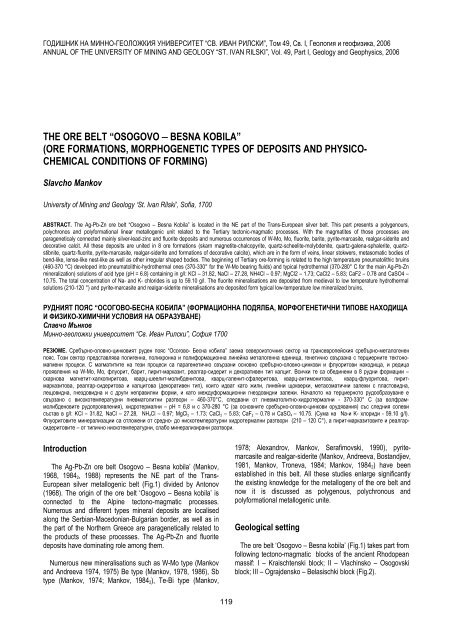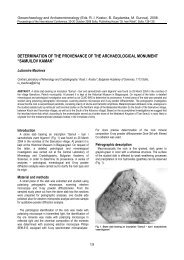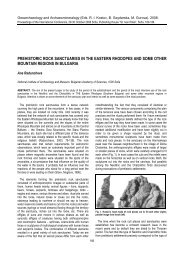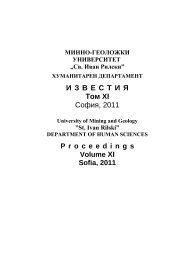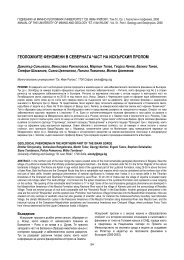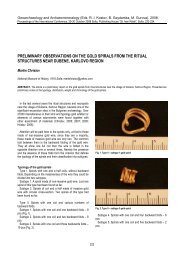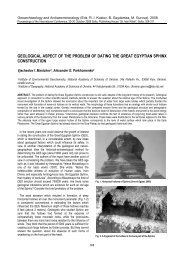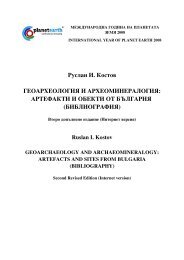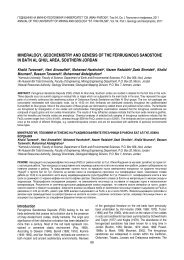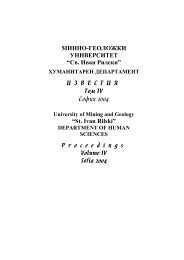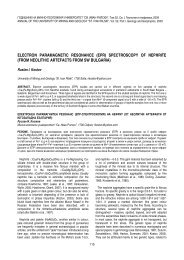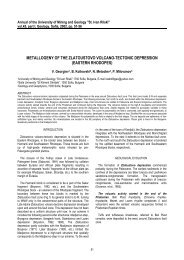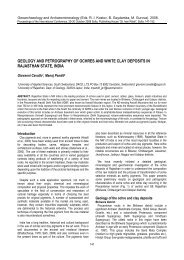tertiary deposits in the ore belt 'osogovo – besna kobila' - Минно ...
tertiary deposits in the ore belt 'osogovo – besna kobila' - Минно ...
tertiary deposits in the ore belt 'osogovo – besna kobila' - Минно ...
You also want an ePaper? Increase the reach of your titles
YUMPU automatically turns print PDFs into web optimized ePapers that Google loves.
ГОДИШНИК НА МИННО-ГЕОЛОЖКИЯ УНИВЕРСИТЕТ “СВ. ИВАН РИЛСКИ”, Том 49, Св. I, Геология и геофизика, 2006<br />
ANNUAL OF THE UNIVERSITY OF MINING AND GEOLOGY “ST. IVAN RILSKI”, Vol. 49, Part I, Geology and Geophysics, 2006<br />
THE ORE BELT “OSOGOVO − BESNA KOBILA”<br />
(ORE FORMATIONS, MORPHOGENETIC TYPES OF DEPOSITS AND PHYSICO-<br />
CHEMICAL CONDITIONS OF FORMING)<br />
Slavcho Mankov<br />
University of M<strong>in</strong><strong>in</strong>g and Geology ‘St. Ivan Rilski’, Sofia, 1700<br />
ABSTRACT. The Ag-Pb-Zn <strong>ore</strong> <strong>belt</strong> “Osogovo <strong>–</strong> Besna Kobila” is located <strong>in</strong> <strong>the</strong> NE part of <strong>the</strong> Trans-European silver <strong>belt</strong>. This part presents a polygenours,<br />
polychronos and polyformational l<strong>in</strong>ear metallogenic unit related to <strong>the</strong> Tertiary tectonic-magmatic processes. With <strong>the</strong> magmatites of those processes are<br />
parageneticaly connected ma<strong>in</strong>ly silver-lead-z<strong>in</strong>c and fluorite <strong>deposits</strong> and numerous occurrences of W-Mo, Mo, fluorite, barite, pyrite-marcasite, realgar-siderite and<br />
decorative calcit. All <strong>the</strong>se <strong>deposits</strong> are united <strong>in</strong> 8 <strong>ore</strong> formations (skarn magnetite-chalcopyrite, quartz-scheelite-molybdenite, quartz-galena-sphalerite, quartzstibnite,<br />
quartz-fluorite, pyrite-marcasite, realgar-siderite and formations of decorative calcite), which are <strong>in</strong> <strong>the</strong> form of ve<strong>in</strong>s, l<strong>in</strong>ear stokwers, metasomatic bodies of<br />
bend-like, lense-like nest-like as well as o<strong>the</strong>r irregular shaped bodies. The beg<strong>in</strong>n<strong>in</strong>g of Tertiary <strong>ore</strong>-form<strong>in</strong>g is related to <strong>the</strong> high temperature pneumatolithic bru<strong>in</strong>s<br />
(460-370 °C) developed <strong>in</strong>to pneumatolithic-hydro<strong>the</strong>rmal ones (370-330° for <strong>the</strong> W-Mo bear<strong>in</strong>g fluids) and typical hydro<strong>the</strong>rmal (370-280° C for <strong>the</strong> ma<strong>in</strong> Ag-Pb-Zn<br />
m<strong>in</strong>eralization) solutions of acid type (pH = 6.8) conta<strong>in</strong><strong>in</strong>g <strong>in</strong> g/l: KCl <strong>–</strong> 31.82, NaCl <strong>–</strong> 27.28, NH4Cl <strong>–</strong> 0.97; MgCl2 <strong>–</strong> 1.73; CaCl2 <strong>–</strong> 5.83; CaF2 <strong>–</strong> 0.78 and CaSO4 <strong>–</strong><br />
10.75. The total concentration of Na- and K- chlorides is up to 59.10 g/l. The fluorite m<strong>in</strong>eralisations are deposited from medieval to low temperature hydro<strong>the</strong>rmal<br />
solutions (210-120 °) and pyrite-marcasite and realgar-siderite m<strong>in</strong>eralisations are deposited form typical low-temperature low m<strong>in</strong>eralized bru<strong>in</strong>s.<br />
РУДНИЯТ ПОЯС “ОСОГОВО-БЕСНА КОБИЛА” (ФОРМАЦИОННА ПОДЯЛБА, МОРФОГЕНЕТИЧНИ ТИПОВЕ НАХОДИЩА<br />
И ФИЗИКО-ХИМИЧНИ УСЛОВИЯ НА ОБРАЗУВАНЕ)<br />
Славчо Мънков<br />
<strong>Минно</strong>-геоложки университет “Св. Иван Рилски”, София 1700<br />
РЕЗЮМЕ. Сребърно-оловно-цинковият руден пояс “Осогово- Бесна кобила” заема североизточния сектор на трансевропейския сребърно-металогенен<br />
пояс. Този сектор представлява полигенна, полихронна и полиформационна линейна металогенна единица, генетично свързана с терциерните тектономагмени<br />
процеси. С магматитите на тези процеси са парагенетично свързани основно сребърно-оловно-цинкови и флуоритови находища, и редица<br />
проявления на W-Mo, Mo, флуорит, барит, пирит-марказит, реалгар-сидерит и декоративен тип калцит. Всички те са обединени в 8 рудни формации <strong>–</strong><br />
скарнова магнетит-халкопиритоав, кварц-шеелит-молибденитова, кварц-галенит-сфалеритова, кварц-антимонитова, кварц-флуоритова, пиритмарказитова,<br />
реалгар-сидеритова и калцитова (декоративен тип), които идват като жили, линейни щокверки, метасоматични залежи с пластовидна,<br />
лещовидна, гнездовидна и с други неправилни форми, и като междуформационни гнездовидни залежи. Началото на терциерното рудообразуване е<br />
свързано с високотемпературни пневматолитни разтвори <strong>–</strong> 460-370°С, следвани от пневматолитно-хидротермални - 370-330° С (за волфраммолибденовите<br />
рудопроявления), хидротермални <strong>–</strong> pH = 6,8 и с 370-280 °С (за основните сребърно-оловно-цинкови орудявания) със следния солеви<br />
състав в g/l: KCl <strong>–</strong> 31.82, NaCl <strong>–</strong> 27.28, NH 4Cl <strong>–</strong> 0.97; MgCl 2 <strong>–</strong> 1.73; CaCl 2 <strong>–</strong> 5.83; CaF 2 <strong>–</strong> 0.78 и CaSO 4 <strong>–</strong> 10.75. (Сума на Na-и K- хлориди - 59.10 g/l).<br />
Флуоритовите минерализации са отложени от средно- до нискотемпературни хидротермални разтвори (210 <strong>–</strong> 120 С°), а пирит-марказитовите и реалгарсидеритовите<br />
<strong>–</strong> от типично нискотемпературни, слабо минерализирани разтвори.<br />
Introduction<br />
The Ag-Pb-Zn <strong>ore</strong> <strong>belt</strong> Osogovo <strong>–</strong> Besna kobila’ (Mankov,<br />
1968, 19842, 1988) represents <strong>the</strong> NE part of <strong>the</strong> Trans-<br />
European silver metallogenic <strong>belt</strong> (Fig.1) divided by Antonov<br />
(1968). The orig<strong>in</strong> of <strong>the</strong> <strong>ore</strong> <strong>belt</strong> ‘Osogovo <strong>–</strong> Besna kobila’ is<br />
connected to <strong>the</strong> Alp<strong>in</strong>e tectono-magmatic processes.<br />
Numerous and different types m<strong>in</strong>eral <strong>deposits</strong> are localised<br />
along <strong>the</strong> Serbian-Macedonian-Bulgarian border, as well as <strong>in</strong><br />
<strong>the</strong> part of <strong>the</strong> Nor<strong>the</strong>rn Greece are paragenetically related to<br />
<strong>the</strong> products of <strong>the</strong>se processes. The Ag-Pb-Zn and fluorite<br />
<strong>deposits</strong> have dom<strong>in</strong>at<strong>in</strong>g role among <strong>the</strong>m.<br />
Numerous new m<strong>in</strong>eralisations such as W-Mo type (Mankov<br />
and Andreeva 1974, 1975) Be type (Mankov, 1978, 1986), Sb<br />
type (Mankov, 1974; Mankov, 19842), Te-Bi type (Mankov,<br />
119<br />
1978; Alexandrov, Mankov, Serafimovski, 1990), pyritemarcasite<br />
and realgar-siderite (Mankov, Andreeva, Bostandjiev,<br />
1981, Mankov, Troneva, 1984; Mankov, 19842) have been<br />
established <strong>in</strong> this <strong>belt</strong>. All <strong>the</strong>se studies enlarge significantly<br />
<strong>the</strong> exist<strong>in</strong>g knowledge for <strong>the</strong> metallogeny of <strong>the</strong> <strong>ore</strong> <strong>belt</strong> and<br />
now it is discussed as polygenous, polychronous and<br />
polyformational metallogenic unite.<br />
Geological sett<strong>in</strong>g<br />
The <strong>ore</strong> <strong>belt</strong> ‘Osogovo <strong>–</strong> Besna kobila’ (Fig.1) takes part from<br />
follow<strong>in</strong>g tectono-magmatic blocks of <strong>the</strong> ancient Rhodopean<br />
massif: I <strong>–</strong> Kraischtenski block; II <strong>–</strong> Vlach<strong>in</strong>sko <strong>–</strong> Osogovski<br />
block; III <strong>–</strong> Ograjdensko <strong>–</strong> Belasischki block (Fig.2).
Fig. 1. Location of <strong>the</strong> Ag-Pb-Zn <strong>ore</strong> <strong>belt</strong> “Osogovo-Besna kobila” (O <strong>–</strong> B) <strong>in</strong> <strong>the</strong> Silver Trans-European <strong>the</strong> <strong>ore</strong> <strong>belt</strong> accord<strong>in</strong>g to Antonov (1986) <strong>–</strong> western<br />
part of <strong>the</strong> Mediterranean folded <strong>belt</strong><br />
Siver-bear<strong>in</strong>g metalogenic prov<strong>in</strong>ces: 1 <strong>–</strong> Alpian; 2 <strong>–</strong> Herz<strong>in</strong>ian (I - Atlas-Andalusian; II <strong>–</strong> D<strong>in</strong>aridian; III <strong>–</strong> Anatolian; IV <strong>–</strong> Alps-Carpa<strong>the</strong>an; V <strong>–</strong> Central Europenean);<br />
3 <strong>–</strong> Central massifs; 4 - geosyncl<strong>in</strong>al lift<strong>in</strong>g, 5 <strong>–</strong> areas <strong>in</strong>volv<strong>in</strong>g Negene vulcanites, 6 <strong>–</strong> abyssal depressions <strong>in</strong> <strong>the</strong> Mediterranean sea, 7 <strong>–</strong> nowadays rift zones.<br />
Deposits of siver-bear<strong>in</strong>g <strong>ore</strong> formations: a) small and middle size, b)large: 8-plumbum-z<strong>in</strong>c-siver, 9 <strong>–</strong> copper-pyrite, 10 <strong>–</strong> copper-pyrite-basemetal, 11 <strong>–</strong> copper<br />
conta<strong>in</strong><strong>in</strong>g schist; 12 <strong>–</strong> gold-silver, 13 <strong>–</strong> 5 element conta<strong>in</strong><strong>in</strong>g. Platforms: AFD <strong>–</strong> African, EEUP <strong>–</strong> East European, ARD <strong>–</strong> Arabian<br />
The geological sett<strong>in</strong>g of <strong>the</strong>se blocks <strong>in</strong>volves Archaic<br />
magmatic-gneiss and metabasite-diabase formations (<strong>the</strong><br />
Ograjdensko <strong>–</strong> Belasischki block), diabase-phyllitoide complex<br />
and high crystall<strong>in</strong>e rocks (Vlach<strong>in</strong>sko-Osogovski and<br />
Kraischtenski blocks) (Bojadjiev, 1971; Mankov and Andreeva,<br />
1974, 1975) cut by later Tertiary magmatites and Mio-Pliocene<br />
sediments overlapped on <strong>the</strong>m vulcanite developed ma<strong>in</strong>ly <strong>in</strong><br />
<strong>the</strong> SE part of <strong>the</strong> <strong>ore</strong> <strong>belt</strong> (<strong>the</strong> Strumitsa and Strumenischki<br />
grabens). In 1992 Alexandrov prolonged <strong>the</strong> <strong>ore</strong> <strong>belt</strong> on SE of<br />
Seres to Tasos Island <strong>–</strong> Greece and described it as <strong>ore</strong>bear<strong>in</strong>g<br />
area.<br />
Tertiary magmatites, which cut <strong>the</strong> three of <strong>the</strong> tectonomagmatic<br />
blocks, form a chaplet-like bend. It starts from<br />
Surdulitsa (Serbia) trough <strong>the</strong> rocks of <strong>the</strong> Vlach<strong>in</strong>sko-<br />
Osogovski block of <strong>the</strong> both sides of <strong>the</strong> Bulgarian-Macedonian<br />
border and it reaches <strong>the</strong> area north of <strong>the</strong> town of Seres<br />
(Greece) <strong>in</strong> sou<strong>the</strong>rn direction (Mankov and Andreeva, 1974,<br />
Mankov, 19842; Alexandrov, 1992). The implementation of <strong>the</strong><br />
Tertiary magmatites was controlled by faults of 295° - 310° to<br />
360° directions. They formed morphlogically different bodies <strong>–</strong><br />
irregular ones, dykes, stocks and sills, which sizes are larger <strong>in</strong><br />
<strong>the</strong> horst lifted parts of Osogovo (Macedonia, Greece), Besna<br />
kobila, Surdulitsa (Serbia) and Scharlia (Greece). They are<br />
acid and middle-acid magmatites, differentiated <strong>in</strong> four<br />
formations <strong>–</strong> dacite-andesitic, dellenite-porphyric, basaltandesite-basaltic<br />
and formation of <strong>the</strong> late subalkal<strong>in</strong>e<br />
volcanites. All <strong>the</strong> Tertiary magmatites from <strong>the</strong> different parts<br />
of <strong>the</strong> <strong>ore</strong> <strong>belt</strong> are differentiated <strong>in</strong> petrochemical aspect trough<br />
<strong>the</strong> normative method of R. Ivanov (1962) (Fig.3) (Mankov and<br />
Andreeva, 1975).<br />
120<br />
All <strong>the</strong> figurative po<strong>in</strong>ts are located <strong>in</strong> <strong>the</strong> field of delenites.<br />
Delenites from Lisets and Vlach<strong>in</strong>a plan<strong>in</strong>a are characterised<br />
by enrichment of K2O and those from <strong>the</strong> Osogovo and<br />
Ograjden mounta<strong>in</strong>s are enriched with Na2O. By its ‘ancontent’<br />
<strong>the</strong> values of magmatites <strong>in</strong> <strong>the</strong> first two of <strong>the</strong> blocks<br />
are closer and differ from those <strong>in</strong> <strong>the</strong> Belasischko-Ograjden<br />
block. The better differentiation of <strong>the</strong> Tertiary magmatites is<br />
expressed on <strong>the</strong> orthogonal diagram Q:AF:CI. Group<strong>in</strong>g of <strong>the</strong><br />
figurative po<strong>in</strong>ts <strong>in</strong> <strong>the</strong> left part of <strong>the</strong> diagram characterises <strong>the</strong><br />
rocks as rich <strong>in</strong> SiO2 of maximal values of dellenites and<br />
dellenite-porphyries of <strong>the</strong> Belasischko-Ograjden block. The<br />
magmatites are characterised by higher content of mafic<br />
m<strong>in</strong>erals (CI) <strong>in</strong> <strong>the</strong> field AF:CI and no significant differences<br />
are established between <strong>the</strong> o<strong>the</strong>r blocks. From <strong>the</strong> o<strong>the</strong>r hand<br />
<strong>the</strong> Tertiary magmatites of <strong>the</strong> Vlach<strong>in</strong>sko-Osogovski block is<br />
characterised by <strong>the</strong> highest total average content of iron<br />
(fm=58) ant those from <strong>the</strong> Kraischtenski block by <strong>the</strong> lowest<br />
one (fm=50). The best differentiation of <strong>the</strong> magmatites is<br />
expressed trough <strong>the</strong> parameter of <strong>the</strong> total alkal<strong>in</strong>ity (AF)<br />
which is 62 for <strong>the</strong> Kraischtenski block, 58 for <strong>the</strong> Vlach<strong>in</strong>sko-<br />
Osogovski and 52 for <strong>the</strong> Belasischko-Ograjdenski block.The<br />
magmatites from <strong>the</strong> Kojuch mounta<strong>in</strong> <strong>in</strong> <strong>the</strong> SE part of <strong>the</strong> <strong>ore</strong><br />
<strong>belt</strong> ‘Osogovo <strong>–</strong> Besna kobila’ are located <strong>in</strong> <strong>the</strong> field of<br />
delenites with <strong>in</strong>creased Na and total alkal<strong>in</strong>ity and <strong>in</strong>creased<br />
content of free quartz (Q). Ivanov and Zidarov (1968) refereed<br />
<strong>the</strong>m to <strong>the</strong> subalkal<strong>in</strong>e volcanites on this base.<br />
Delleneite-porphyry formation and <strong>the</strong> formation of later<br />
subalkal<strong>in</strong>e volcanites formed dur<strong>in</strong>g <strong>the</strong> two magmatic stages<br />
<strong>–</strong> Oligocene-Miocene and Pliocene have <strong>the</strong> most important<br />
role for <strong>the</strong> ma<strong>in</strong> types of <strong>the</strong> <strong>ore</strong> m<strong>in</strong>eralisations. They are<br />
overlapped on <strong>the</strong> thick consolidated Pre-Cambrian and old
Paleozoic Earth c<strong>ore</strong>. This c<strong>ore</strong> determ<strong>in</strong>ed <strong>the</strong> formation of so<br />
called granitophilic <strong>ore</strong> formations connected to <strong>the</strong> acid<br />
magmatism (Dimitrov, Kolkovski, Mankov, 1979). They differ<br />
from <strong>the</strong> <strong>ore</strong> formations localised <strong>in</strong> <strong>the</strong> SW part of <strong>the</strong> Trans-<br />
European silver <strong>belt</strong> determ<strong>in</strong>ed by Antonov (1986).<br />
Serafimovski (1990) describes this part as ‘<strong>ore</strong> zone Lecce-<br />
Chalcidiki’. The Earth c<strong>ore</strong> is relatively th<strong>in</strong> <strong>in</strong> this area and it<br />
has andesitic characteristics.<br />
Fig. 2. Metallogenic scheme of <strong>the</strong> <strong>ore</strong> <strong>belt</strong> ‘Osogovo-Besna kobila<br />
(Mankov, 1968; Mankov and Andreeva, 1974, Mankov, 19842; Alexandrov,<br />
1992)<br />
1 <strong>–</strong> Quaternary and Neogene; 2 <strong>–</strong> Pliocene subalkal<strong>in</strong>e vulcanite; 3 <strong>–</strong> Miocene<br />
granodiorite; 4 <strong>–</strong> Paleogene vulcanite; 5 <strong>–</strong> Paleogene sediment rocks; 6 <strong>–</strong><br />
Triassic; 7 <strong>–</strong> Paleosoic; 8 <strong>–</strong> Staraplan<strong>in</strong>a granite; 9 <strong>–</strong> Vlach<strong>in</strong>sko-Osogovo lowmetamorphic<br />
rocks; 10 <strong>–</strong> Archean and proterosoic high-metamorphic rocks.<br />
Deposits and <strong>ore</strong> occurrences: 11 a<br />
<strong>the</strong> Kojuch decorative calcite deposit<br />
(paramorphosis of calcite and aragonite); 11 b<br />
<strong>–</strong> pyrite-marcasite <strong>ore</strong><br />
occurrences (1. Levunovska cariera. 2. Churichene. 3. Zlatarevo. 4. Zoichan.<br />
5. Gega.); 11 c<br />
<strong>–</strong> <strong>the</strong> Slavianka fluorite deposit; 12. stibnite deposit and <strong>ore</strong><br />
occurrences (1. Krastov dol. 2. Ravnio rid. 3. Ivanic); 13. ma<strong>in</strong> Pb-Zn <strong>deposits</strong><br />
and <strong>ore</strong> occurrences (1. Blagodat. 2. Dolno Taml<strong>in</strong>o. 3. Konev kamen. 4.<br />
Popradlovitza. 5. Bojilovo lejiste. 6. Podvirovi. 7. Plaviloto. 8. Samar.<br />
9.Lebnitza. 10.Ruen. 11. Mali Ruen. 12. Toranitza. 13. Sasa. 14. Pehchevo.<br />
15. Kadiitza. 16. G<strong>ore</strong>mski hanove. 17. Topolnitza. 18. Scharalia) 14 <strong>–</strong> W-Mo<br />
<strong>deposits</strong> and <strong>ore</strong> occurrences (1. Matchkatitza. 2. Stari glog. 3. Leshtarska<br />
mahala. 4. Delchevski dol. 5. Svlachishteto. 6. Saska karaula. 7. Siar.); 15 <strong>–</strong><br />
Skarn-magnetite <strong>ore</strong> occurrences (1. Golemi and Malki lisichi dupki. 2.<br />
Svlachishteto); 16 <strong>–</strong> tectonic faults and thrusts; 17 <strong>–</strong> tectonic blocks (I <strong>–</strong><br />
Kraishtenski. II <strong>–</strong> Vlach<strong>in</strong>sko-Osogovski. III <strong>–</strong> Belasishko-Ograjdenski); 18 <strong>–</strong><br />
Rhodopa massive; 19 <strong>–</strong> boundaries of <strong>the</strong> <strong>ore</strong> <strong>belt</strong>.<br />
121<br />
Fig. 3. or:ab:an diagram and ±Q:AF:CI diagram of Tertiary magmatites<br />
from <strong>the</strong> Kraishtenski (I), Vlach<strong>in</strong>sko-Osogovski (II) and Belasishko-<br />
Ograjdenski (III) tectono-magmatic blocks (Mankov and Andreeva, 1974,<br />
1975; Andreeva, 1979)<br />
(1 <strong>–</strong> dellenite from <strong>the</strong> Lisets mounta<strong>in</strong>, 2 <strong>–</strong> dellenite-porphyry from Central<br />
Osogovo, 3 <strong>–</strong> dellenite and dellenite-porphyry from <strong>the</strong> mounta<strong>in</strong>s of Ograjden<br />
and Malashevska, 4 <strong>–</strong> dellenite and dellenite-porphyry from Vlach<strong>in</strong>a mounta<strong>in</strong>,<br />
5 <strong>–</strong> subalkal<strong>in</strong>e dellenite from Kojuch, Petrich district)<br />
The form<strong>in</strong>g of <strong>the</strong> dellenite-porphyry formation <strong>in</strong> Oligocene-<br />
Miocene stage has been realised dur<strong>in</strong>g <strong>the</strong> time of <strong>the</strong> two<br />
magmatic impulses. F<strong>in</strong>e porphyry dellenite-porphyries are<br />
related to <strong>the</strong> first impulse and <strong>the</strong> coarse-gra<strong>in</strong>ed delleniteporphyries<br />
are connected to <strong>the</strong> second impulse. They are<br />
largely manifested <strong>in</strong> <strong>the</strong> whole <strong>ore</strong> <strong>belt</strong>. Numerous skarn and<br />
W-Mo <strong>ore</strong> occurrences and <strong>deposits</strong> (Surdulischi block, Central<br />
Osogovo, Scharlia) are genetically and paragenetically related<br />
to <strong>the</strong> first type of rocks.Ag-Pb-Zn <strong>deposits</strong> and <strong>the</strong> <strong>ore</strong><br />
occurrences are paragenetically related to <strong>the</strong> second type<br />
(Dragov, 1965; Mankov, 1968, 1988).<br />
The Pliocene magmatic stage is manifested <strong>in</strong> <strong>the</strong> Central<br />
Osogovo <strong>in</strong> <strong>the</strong> form of meridianal oriented dykes from latiteandesite<br />
porphyrites along <strong>the</strong> marg<strong>in</strong>al parts of <strong>the</strong> volcanic<br />
diatreme Chucarevtsi as well as magmatites from <strong>the</strong> Kojuch<br />
volcano (on <strong>the</strong> cross<strong>in</strong>g of Struma and Strumescnitsa<br />
grabens) are related to this stage <strong>in</strong> <strong>the</strong> SE part of <strong>the</strong> <strong>ore</strong> <strong>belt</strong>.<br />
Numerous <strong>ore</strong> occurrences and <strong>deposits</strong> of quartz-stibnite and<br />
quartz-flourite as well as ra<strong>the</strong>r specific pyrite-marcasite and<br />
realgar-siderite m<strong>in</strong>eralisations <strong>in</strong> <strong>the</strong> sou<strong>the</strong>rn part of <strong>the</strong><br />
Struma graben on Bulgarian territory are paragenetically<br />
related to this type of magmatism.
Formation sysematics of <strong>the</strong> m<strong>in</strong>eralisations<br />
Tertiary m<strong>in</strong>eralisations <strong>in</strong> <strong>the</strong> <strong>ore</strong> <strong>belt</strong> ‘Osogovo <strong>–</strong> Besna<br />
kobila’ are typical polygenous, polychronous and<br />
polyformational m<strong>in</strong>eral products and are localised is several<br />
<strong>ore</strong> fields. M<strong>ore</strong> important <strong>ore</strong> fields are Ruen (on Bulgarian<br />
and Macedonian territory), Karamanishko (on Serbian and<br />
Macedonian territory), Machatichko (on Serbian territory) and<br />
Seres (on Greece territory). They are divided <strong>in</strong>to two <strong>ore</strong><br />
complexes depend<strong>in</strong>g on <strong>the</strong> lead<strong>in</strong>g elements: Ag-Pb-Zn<br />
(Oligocene-Miocene) and As-Sb-F (Pliocene). They could be<br />
divided from formation po<strong>in</strong>t of view <strong>in</strong>to 8 <strong>ore</strong> formations:<br />
scarn-magnetite-chalcopyrite (scarn Fe-oxide), quartz <strong>–</strong><br />
scheelite-molybdenite, quartz-galena-sphalerite, quartzstibnite,<br />
pyrite-marcasite, quartz-fluorite, realgar-siderite and<br />
formation of decorative calcite. All of <strong>the</strong>se <strong>ore</strong> formations<br />
<strong>in</strong>volves several m<strong>in</strong>eralogical-geochemical types <strong>deposits</strong> and<br />
<strong>ore</strong> occurrences which are characterised by specific m<strong>in</strong>eral<br />
compositions, trace elements, textural and structural features,<br />
morphology of <strong>ore</strong> bodies, type of <strong>the</strong> host rocks and specific<br />
role of metasomatic processes.<br />
Scarn magnetite-chalcopyrite <strong>ore</strong> formation. It <strong>in</strong>volves all<br />
<strong>the</strong> Fe-scarn occurrences <strong>in</strong> <strong>the</strong> Central Osogovo, Blagodat<br />
and Karamanitsa. The m<strong>in</strong>eralisation is found as massive and<br />
ve<strong>in</strong>ed-banded aggregates of magnetite, chalcopyrite,<br />
galenobismutite, aik<strong>in</strong>ite, crupcaite, cosalite, o<strong>the</strong>r<br />
undiagnosed medium members of aik<strong>in</strong>ite-bismuth<strong>in</strong>ite series,<br />
tetradimite and native bismuth. They are overlapped on <strong>the</strong><br />
andradite-grosular scarns and massive epidosites developed<br />
on marbles and green-schist rocks of <strong>the</strong> diabase-philitoidic<br />
complex not far from <strong>the</strong> larger bodies from <strong>the</strong> f<strong>in</strong>e-porphyry<br />
dellenite-porphyries of <strong>the</strong> first impulse of <strong>the</strong> dellenite<br />
porphyry formation. They are extremely largely distributed <strong>in</strong><br />
<strong>the</strong> SE part of <strong>the</strong> Ruen <strong>ore</strong> field (Fig.4 and Fig. 5).<br />
Quartz-scheelite-molybdenite <strong>ore</strong> formation. The<br />
formation <strong>in</strong>volves many W-Mo <strong>ore</strong> occurrences located <strong>in</strong> <strong>the</strong><br />
SE part of <strong>the</strong> Ruen <strong>ore</strong> field <strong>in</strong> Central Osogovo (Mankov,<br />
Andreeva, 1974, Mankov, Andreeva, 1974, 1975, Alexandrov,<br />
1992), several W and Mo <strong>ore</strong> occurrences <strong>in</strong> <strong>the</strong> Surdulischki<br />
block from <strong>the</strong> most NW flank of <strong>the</strong> <strong>ore</strong> <strong>belt</strong> (Jankovich,<br />
19955, Simic, 1995) and some small <strong>ore</strong> occurrences <strong>in</strong><br />
Ograjden block (Bulgaria) and <strong>in</strong> Sharlia (Greece). All <strong>the</strong>se W-<br />
Mo m<strong>in</strong>eralisations are related to <strong>the</strong> most lifted blocks with<strong>in</strong><br />
<strong>the</strong> frame of <strong>ore</strong> <strong>belt</strong> ‘Osogovo <strong>–</strong> Besna kobila’. They are<br />
presented by a series of quartz-molybdenite, quartz-ferberitescheelite,<br />
quartz-ferberite and quartz-pyrite ve<strong>in</strong>s and<br />
dissem<strong>in</strong>ation localised ma<strong>in</strong>ly <strong>in</strong> WN zones of fault<strong>in</strong>g and<br />
cataclasis among f<strong>in</strong>e porphyry dellenites, developed most<br />
significantly <strong>in</strong> <strong>the</strong> Central Osogovo. M<strong>in</strong>eralisations <strong>in</strong> <strong>the</strong>m<br />
are most <strong>in</strong>tensive <strong>in</strong> <strong>the</strong> cross<strong>in</strong>g po<strong>in</strong>t of <strong>the</strong> zones and one<br />
large longitud<strong>in</strong>al zone of fault<strong>in</strong>g which is <strong>ore</strong>-bear<strong>in</strong>g and <strong>ore</strong>controll<strong>in</strong>g<br />
one (Mankov, 1988). Similar of <strong>the</strong>ir characteristics<br />
are m<strong>in</strong>eralisations <strong>in</strong> <strong>the</strong> Surdulishki block <strong>–</strong> <strong>ore</strong> deposit<br />
Matchkatitsa. Typical trace elements are Bi, Te, Cu, Sn, Pb, Zn<br />
and specific zeolitisation <strong>–</strong> late heilandite m<strong>in</strong>eralisation.<br />
Typical metasomatites quartz<strong>–</strong>K feldspathization (Mankov and<br />
Andreeva, 1973).<br />
122<br />
Quartz-galena-sphalerite <strong>ore</strong> formation. It is presented by<br />
21 <strong>deposits</strong> and 168 <strong>ore</strong> occurrences. Significant reserves of<br />
three elements Ag-Pb-Zn are confirmed (Sasa deposit <strong>–</strong><br />
Macedonia), Ruen deposit with its two sections <strong>–</strong> Central and<br />
Shapka; <strong>the</strong> Mali Ruen deposit - sections Central and Belite<br />
sipei. The last three <strong>deposits</strong> are situated <strong>in</strong> <strong>the</strong> Ruen <strong>ore</strong> field<br />
<strong>in</strong> Bulgaria. The <strong>deposits</strong> from this formation are typical Ag-Pb-<br />
Zn ones by <strong>the</strong>ir m<strong>in</strong>eral composition conta<strong>in</strong><strong>in</strong>g as well<br />
<strong>in</strong>creased contents of Cd, In, Sb, As, Bi, Te and Au. The last<br />
studies established also <strong>in</strong>creased contents of Be, which forms<br />
its own m<strong>in</strong>eral <strong>–</strong> helv<strong>in</strong>e (Mankov, 1978, Mankov, 1986), Sn<br />
which is very typical element for <strong>the</strong> ma<strong>in</strong> quartz-sulphide<br />
paragenesis from (300 to 600 g/t) <strong>in</strong> <strong>the</strong> form of isomorphic<br />
mixture <strong>in</strong> chalcopyrite and pyrrothite or as kesterite<br />
(Cu2ZnSnS4) and one new (not well studied) Sn-Cu phase.<br />
Deposits and <strong>ore</strong> occurrences from this formation are related<br />
ma<strong>in</strong>ly to <strong>the</strong> large W-NW, NW longitud<strong>in</strong>al fault<strong>in</strong>g zones and<br />
zones of cataclasis affect<strong>in</strong>g f<strong>in</strong>e- and coarse<strong>–</strong>porphyries<br />
dellenite-porphyrites as well as high- and low- crystall<strong>in</strong>e rocks.<br />
The most significant <strong>ore</strong> bodies <strong>in</strong> many cases are localised <strong>in</strong><br />
marble among quartz-graphite schist, among cataclased<br />
isotropic dellenites and green schist by metasomatic processes<br />
<strong>–</strong> it means that multicentral metasomatosis over silicified and<br />
carbonate rocks is developed. Typical metasomatites around<br />
<strong>ore</strong>s are products of quartz-sericite metasomatic formation<br />
(unpublished data by Andreeva).<br />
Quartz-stibnite <strong>ore</strong> formation. It is presented by 4 ve<strong>in</strong><br />
<strong>deposits</strong> and <strong>ore</strong> occurrences localised <strong>in</strong> <strong>the</strong> board parts of<br />
<strong>the</strong> Precolnishki graben (NW part of <strong>the</strong> Ruen <strong>ore</strong> field),<br />
Ravnio rid <strong>–</strong> S from Gueshevo and Krastov dol (Macedonia)<br />
and N and S part of <strong>the</strong> Belasitza horst on Bulgarian and<br />
Greece territory (Fig.2 and Fig.4). Theref<strong>ore</strong> <strong>the</strong>se are sections<br />
of <strong>the</strong> <strong>ore</strong> <strong>belt</strong> ‘Osogovo <strong>–</strong> Besna kobila’ which have <strong>the</strong> lowest<br />
erosion level and <strong>the</strong>y occupied reasonable position on <strong>the</strong><br />
background of <strong>the</strong> total distribution of all <strong>deposits</strong> related<br />
paragenetically to <strong>the</strong> f<strong>in</strong>e-porphyry and coarse-porphyry<br />
dellenite-porphyries. Increased contents of Hg, Ag, Au, Te, Pb<br />
and Zn as well as quartz-argillite metasomatites are typical for<br />
<strong>the</strong> occurrences of this formation.<br />
Quartz-fluorite formation is presented by 4 occurrences <strong>in</strong><br />
<strong>the</strong> Ruen <strong>ore</strong> field found out by Dimitrov (1945), Mankov<br />
(1974), Zagorchev and Ruseva (1982) and one quartz-fluorite<br />
deposit (Slavjanka) that is situated with<strong>in</strong> crystall<strong>in</strong>e rocks and<br />
Miocene sediments <strong>in</strong> Ograjden block near <strong>the</strong> western board<br />
of <strong>the</strong> Struma graben (Todorov, 1984) and also by several <strong>ore</strong><br />
occurrences <strong>in</strong> <strong>the</strong> Maleshevska mounta<strong>in</strong> (Krastiltzi and<br />
Karpelevo) (Mihov et al., unpublished data). Typical trace<br />
element for this formation is As and quartz-argillite type<br />
metasomatites (Todorov, 1984). Two of <strong>ore</strong> occurrences <strong>in</strong><br />
Ruen <strong>ore</strong> field are related to <strong>the</strong> W-NW and meridian to <strong>the</strong> N-<br />
NE fault zone <strong>in</strong> dellenites cutt<strong>in</strong>g <strong>the</strong> ma<strong>in</strong> Ag-Pb-Zn<br />
m<strong>in</strong>eralisation. The o<strong>the</strong>r two occurrences are related to <strong>the</strong><br />
marbelous limestone from <strong>the</strong> basement of <strong>the</strong> Eleshnitza<br />
allochthon over <strong>the</strong> Osogovo autochthon (Zagorchev, Ruseva,<br />
1982) on <strong>the</strong> cross<strong>in</strong>g po<strong>in</strong>t of fault<strong>in</strong>g zones W-NW direction<br />
and meridian faults. This fact determ<strong>in</strong>es <strong>the</strong>ir nest-like shapes<br />
which is different from <strong>the</strong> expected layered-like, that is why<br />
<strong>the</strong> possibilities for found<strong>in</strong>g out fluorite m<strong>in</strong>eralisations of<br />
economic importance <strong>in</strong> <strong>the</strong> Ruen <strong>ore</strong> field are limited.
Fig. 4. Ore formations and m<strong>in</strong>eral types <strong>deposits</strong> and <strong>ore</strong> occurrences <strong>in</strong> <strong>the</strong> Ruen <strong>ore</strong> field (Mankov, 1974; Mankov, 1988; Aleksandrov, 1992)<br />
A. Skarn magnetite-chalcopyrite: a)andradite-magnetite epidote (1- Golemi lisischi dupki; 2 <strong>–</strong> Malki lisichi dupki, 3 <strong>–</strong> Zeleni dol, 4 <strong>–</strong> Svlachishteto, 5 <strong>–</strong> Lagera); b)<br />
pyroxene-specularite epidote (6 <strong>–</strong> Zlatanski dol, 7 <strong>–</strong> Ilan dere); c) andradite-epidote-galena ( 8 <strong>–</strong> Petsovska mahala, 9 <strong>–</strong> Petrova niva). B. Quartz-scheelitemolybdenite:<br />
a) quartz-albite-molybdenite scheelite (10 <strong>–</strong> Svlachishteto, 11 <strong>–</strong> Pchel<strong>in</strong>a, 12 <strong>–</strong> Murni dol, 13 <strong>–</strong> Saska karaula); b)quartz-molybdenite (14 - Delchevski<br />
dol, 15 <strong>–</strong> Chukarevtzi, 16 <strong>–</strong> Lis<strong>in</strong> dol, 17 <strong>–</strong> Saravska mahala), C.Quartz-galena-sphalerite: a)diopsite-jochansenite-bustamite (18 <strong>–</strong> Sasa); b) sphalerite-galena with<br />
low distribution of gangue m<strong>in</strong>erals (19 <strong>–</strong> Ruen, central part, 20 <strong>–</strong> Belite sipei, 21 <strong>–</strong> Jdrapanitza II, 22 <strong>–</strong> Prosechenik, 23 <strong>–</strong> Petrova reka, 24 <strong>–</strong> Ruen (Macedonia), 25 <strong>–</strong><br />
Bachilski potok); c) galena-sphalerite predom<strong>in</strong>ated by quartz and carbonates (26 <strong>–</strong> Lebniotza I, 27 <strong>–</strong> Lebniotza II, 28 <strong>–</strong> Ravna niva, 29 <strong>–</strong> Sredno burdo); d)quartzrodonite-basemetal<br />
with silver m<strong>in</strong>erals (30 <strong>–</strong> Ruen, Shapka section, 31 <strong>–</strong> Mali Ruen, 32 <strong>–</strong> Shapka II); e) johannsenite-rodonite with galena and sphalerite (33 <strong>–</strong> Nivite,<br />
34 <strong>–</strong> Mali Ruen <strong>–</strong> zone 4 and 5, 35 <strong>–</strong> Belite sipei <strong>–</strong> metasomatic body). D. Quartz-stibnite: a) quartz-stibnite (36 <strong>–</strong> Ravnio rid) E. Quartz- fluorite: - a) fluorite (37 -<br />
Tsurna reka, 39 <strong>–</strong> Chekanets, 40 <strong>–</strong> Zid<strong>in</strong>tsi); b) barite-fluorite (38 <strong>–</strong> Ruen).<br />
Pyrite-marcasite <strong>ore</strong> formation is established <strong>in</strong> <strong>the</strong><br />
sou<strong>the</strong>rn part of <strong>the</strong> <strong>ore</strong> <strong>belt</strong> <strong>in</strong> <strong>the</strong> cross<strong>in</strong>g po<strong>in</strong>t with <strong>the</strong><br />
Struma graben (Mankov, Andreeva, Bostanjiev, 1981). It is<br />
presented by massive layered pyrite-marcasite aggregates<br />
developed over <strong>the</strong> basal breccia-conglomerate of Neogene<br />
sediments of <strong>the</strong> Struma graben (<strong>ore</strong> occurrences Levunovska<br />
kariera) as well as by series of ve<strong>in</strong> pyrite-marcasite <strong>ore</strong><br />
occurrences <strong>–</strong> Saichan, Zlatarevo, Churichene, Kozuch, which<br />
are located along <strong>the</strong> nor<strong>the</strong>rn edge of <strong>the</strong> Struma graben<br />
among <strong>in</strong>tensively altered high-crystall<strong>in</strong>e rocks of <strong>the</strong><br />
Ograjden block. Typical elements for this formation are As, Ba<br />
and F (Mankov, 1984) and quartz-argillite type metasomatites.<br />
123<br />
Realgar-siderite <strong>ore</strong> formation is presented by layered<br />
siderite body among <strong>the</strong> Neogen sedeiments <strong>in</strong> <strong>the</strong> area of<br />
Damianitza village <strong>–</strong> sou<strong>the</strong>rn part of Struma granben. The<br />
body is cut by series of realgar ve<strong>in</strong>lets (Mankov, Andreeva,<br />
Bostanjiev, 1981). The formation of realgar is related to <strong>the</strong><br />
active hydro<strong>the</strong>rmal reprocess<strong>in</strong>g of <strong>the</strong> massive pyritemarcasite<br />
bodies from <strong>the</strong> lower part of Neogen section. As a<br />
result significant quantities of As are isomorphicaly <strong>in</strong>cluded <strong>in</strong><br />
pyrite lattice (Mankov, 1984; Mankov,Troneva, 1984). This way<br />
<strong>the</strong> Neogen <strong>ore</strong> formations are located <strong>in</strong> two levels <strong>–</strong><br />
marcasite-pyrite formation occupies lower level and realgarsiderite<br />
formation is developed <strong>in</strong> <strong>the</strong> upper level (Fig.10).
Fig. 5. Nest- and lens-like scarn-magnetite <strong>ore</strong> bodies from SE part of <strong>the</strong> Ruen <strong>ore</strong> field, Bulgaria (a <strong>–</strong> development of zonal scarns <strong>in</strong> xenolites of quartzchlorite<br />
schist <strong>in</strong> f<strong>in</strong>e-porphyry dellenites. Lagera <strong>ore</strong> occurrence; b <strong>–</strong> development of granate-epidote skarns <strong>in</strong> gabrodiorite. Lisich<strong>in</strong> dol <strong>ore</strong> occurrence.<br />
(Andreeva, 19771) 1 <strong>–</strong> epidosite, 2 <strong>–</strong> granate-epidote skarns with magnetite, 3 <strong>–</strong> andradite-grosular zone, 4 <strong>–</strong> zone of epidotised quartz-chlorite schist, 5 <strong>–</strong> zone of<br />
<strong>in</strong>tensive fault<strong>in</strong>g and cataclasis with pyritisation (a) and without pyrite (b), 6 <strong>–</strong> f<strong>in</strong>e-porphyry dellenite, 7 <strong>–</strong> gabrodiorite, 8 <strong>–</strong> quartz-chlorite schist, 9 <strong>–</strong> muscovite<br />
gneiss, 10 <strong>–</strong> faults, 11 <strong>–</strong> trenches.<br />
Formation of decorative calcite is typical for <strong>the</strong><br />
volcanites from <strong>the</strong> hill of Kozuch. It is presented by a large<br />
but flat cone-like calcite body elongated <strong>in</strong> W-NW direction<br />
(Petrov, 1963, Milanova, 1965, unpublished data). Calcite is<br />
developed as paramorphosis of aragonite.<br />
Morphogenetic types <strong>deposits</strong> and <strong>ore</strong><br />
occurrences<br />
M<strong>in</strong>eral formation from <strong>the</strong> Tertiary post-magmatic fluids <strong>in</strong><br />
<strong>the</strong> <strong>ore</strong> <strong>belt</strong> ‘Osogovo <strong>–</strong> Besna kobila’ is <strong>in</strong> different zones of<br />
free <strong>in</strong>filtration dra<strong>in</strong>age or <strong>in</strong> relatively closed diffusionmetasomatic<br />
system and rarely <strong>in</strong> <strong>the</strong> contractive fractures of<br />
<strong>the</strong> apical parts of larger Tertiary magmatic bodies. The<br />
different lithologic composition of <strong>the</strong> host rocks and <strong>the</strong><br />
orientation of some of <strong>the</strong>ir elements (such as foliation,<br />
<strong>in</strong>cl<strong>in</strong>ation) to <strong>the</strong> orientation of <strong>the</strong> <strong>ore</strong>-bеar<strong>in</strong>g solution<br />
movemеnt gives <strong>the</strong> additional reflection on <strong>the</strong> morphogenetical<br />
variations of <strong>ore</strong> <strong>deposits</strong> and occurrences and<br />
<strong>the</strong>ir <strong>ore</strong> bodies. On <strong>the</strong> o<strong>the</strong>r hand <strong>the</strong> physico-chemical<br />
nature of <strong>the</strong> <strong>ore</strong>-bear<strong>in</strong>g solutions (T, P, C) reflects to <strong>the</strong><br />
velocity and <strong>in</strong>tensity of m<strong>in</strong>eral precipitation (chemical<br />
destruction of some m<strong>in</strong>erals and formation of o<strong>the</strong>r<br />
m<strong>in</strong>erals) and implements new features <strong>in</strong> morphogenetic<br />
variations of <strong>ore</strong> <strong>deposits</strong>.<br />
124<br />
The follow<strong>in</strong>g morphogenetic <strong>ore</strong> types could be divided<br />
dist<strong>in</strong>ctly on <strong>the</strong> basis of mentioned above (Mankov, 1974;<br />
Mankov, 1988; Alexandrov, 1992): 1. Ve<strong>in</strong>s; 2. L<strong>in</strong>ear<br />
stockworks; 3. Metasomatic bodies of layer-like, lens-like and<br />
o<strong>the</strong>r irregular shapes; 4. In-formation nest-like bodies. Two<br />
<strong>ore</strong> m<strong>ore</strong> morphogenetic type <strong>ore</strong> bodies are often formed <strong>in</strong><br />
particular deposit.<br />
The ve<strong>in</strong> type <strong>in</strong>volves several Pb-Zn <strong>deposits</strong> <strong>in</strong> <strong>the</strong> Ruen<br />
<strong>ore</strong> field (Lebnitza I, Lebnitsa II, Ravna niva <strong>–</strong> Bulgaria;<br />
Sredno bardo, Ruen, Petrova reka, some of <strong>the</strong> bodies <strong>in</strong> <strong>the</strong><br />
Sasa deposit and Bachilski potok <strong>–</strong> Macedonia), some<br />
<strong>deposits</strong> from <strong>the</strong> Karamanishko <strong>ore</strong> field (Podvirovi,<br />
Karamanitza <strong>–</strong> Serbia; Samar, Kukishte, Turska straja,<br />
Bagremi <strong>–</strong> Macedonia), Pb-Zn <strong>deposits</strong> <strong>in</strong> <strong>the</strong> Pehchevo <strong>ore</strong><br />
field (Pehchevo, Pehchevska reka, Racovets Kadiitza <strong>in</strong><br />
Macedonian and Bulgarian territory). This type <strong>in</strong>volves also<br />
fluorite deposit Slavianca, stibnite <strong>ore</strong> occrrences Ivanic and<br />
Ravnio rid from <strong>the</strong> sou<strong>the</strong>rn and central part of <strong>the</strong> Osogovo<br />
block, stibnite deposit Krastov dol <strong>in</strong> Macedonia which is<br />
located <strong>in</strong> <strong>the</strong> Karamanitsa <strong>ore</strong> field.<br />
These m<strong>in</strong>eralisations are located <strong>in</strong> different gneiss,<br />
gneiss-graniteq granodiorite, green schist rocks and rarely <strong>in</strong><br />
dellenite and large, steep, longitud<strong>in</strong>al up to <strong>the</strong> NW and EW<br />
fault structures (Fig.6). They are quartz and quartz-carbonate<br />
ve<strong>in</strong>s that conta<strong>in</strong> sulphides, dipp<strong>in</strong>g <strong>in</strong>to W to SW (75-80°)<br />
and dist<strong>in</strong>ct contacts with host rocks. They are traced on <strong>the</strong>
surface from 100<strong>–</strong>150 m (Ravna niva) up to 2000 m<br />
(Lebnitza I and Lebnitza II) and up to 700 m <strong>in</strong> vertical<br />
direction. In depth <strong>the</strong>y have tendency to divide <strong>in</strong> a form of a<br />
hand with open f<strong>in</strong>gers po<strong>in</strong>t<strong>in</strong>g down (Lebnitza I). Anisotropy<br />
characteristic of <strong>the</strong> host rocks determ<strong>in</strong>ed one-way open<strong>in</strong>g<br />
of <strong>ore</strong>-bear<strong>in</strong>g faults dur<strong>in</strong>g <strong>the</strong> different moments of <strong>the</strong><br />
development of m<strong>in</strong>eralisation process which is a reason for<br />
form<strong>in</strong>g typical <strong>ore</strong> ve<strong>in</strong>s of massive, breccia-like, banded,<br />
druses, cockard and spoty structures <strong>in</strong> open fractures.<br />
Typical ve<strong>in</strong> bodies <strong>in</strong> <strong>the</strong> Podvirovi <strong>deposits</strong><br />
(Karamanishko <strong>ore</strong> field) are located along <strong>the</strong> faults on <strong>the</strong><br />
contact of low-crystall<strong>in</strong>e rocks and coarse-porphyry dellenite<br />
(Petrovic, 1981; Simic, 1995). Typical l<strong>in</strong>ear stockwork from<br />
10 to 40 m wide are established <strong>in</strong> depth among <strong>the</strong> isotropic<br />
dellenite porphyry bodies.<br />
The second structural-morphological type <strong>deposits</strong><br />
and occurrences <strong>–</strong> l<strong>in</strong>ear stockworks and stockwork-ve<strong>in</strong><br />
type <strong>deposits</strong> are related to <strong>the</strong> large zones of fault<strong>in</strong>g and<br />
cataclasis, ma<strong>in</strong>ly with W-NW direction <strong>–</strong> 295-305° dipp<strong>in</strong>g <strong>in</strong><br />
SW and W-NW (70-75°) and very rarely <strong>–</strong> to <strong>the</strong> N-NE fault<br />
zones. This type unites <strong>deposits</strong> which belong to different <strong>ore</strong><br />
formations and m<strong>in</strong>eralogical types (<strong>in</strong> Bulgaria <strong>–</strong> Ag-Pb-Zn<br />
<strong>deposits</strong> Ruen, sections Central and Shapka; Mali Ruen,<br />
sections Central and Belite sipei, Jdrapanitza II; W-Mo <strong>ore</strong><br />
occurrences Svlachishteto, Chcarevtzi, Delchevski dol and<br />
Manastirski dol; <strong>in</strong> Macedonia <strong>–</strong> Pb-Zn <strong>deposits</strong> Ruen,<br />
Bachiloto and Plaviloto, W-Mo occurrences Saska Karaula<br />
and Sarafska mahala; <strong>in</strong> Serbia <strong>–</strong> W-Mo <strong>deposits</strong><br />
Matchkatitza and Borovic and Pb- Zn deposit Karamanitza).<br />
Some of <strong>the</strong>se <strong>deposits</strong> have economical importance.<br />
M<strong>in</strong>eralisations could be followed from 50 <strong>–</strong> 60 m up to 3000<br />
m (Ruen, Belite sipei, Mali Ruen, Matchkalitza). The vertical<br />
<strong>in</strong>terval of m<strong>in</strong>eralisation is over 750 m <strong>in</strong> some of <strong>the</strong>m. Ore<br />
bodies are characterised by very complicated shapes and<br />
irregular distribution of m<strong>in</strong>erals manifested by metasomatic,<br />
multicentral eveloped quartz-sulphide-carbonate<br />
iimpregnation and veilets, ma<strong>in</strong>ly among <strong>the</strong> isotropic f<strong>in</strong>e<br />
and coarse-porphyry dellenite (Fig. 7 and Fig. 8 a, b, h).<br />
Different <strong>in</strong> <strong>the</strong>ir morphology and geological sett<strong>in</strong>g<br />
metasomatic <strong>ore</strong> bodies and m<strong>in</strong>eralised zones determ<strong>in</strong>ed<br />
as overlapped metasomatites were formed <strong>in</strong> different <strong>in</strong> <strong>the</strong>ir<br />
composition host rocks. The whole development of <strong>the</strong>se<br />
metasomatites leads to <strong>the</strong> total reproduction of structural<br />
and textural peculiarities of <strong>the</strong> replaced dellenite-porphyries.<br />
The ma<strong>in</strong> part of <strong>the</strong> <strong>ore</strong> bodies <strong>in</strong> <strong>the</strong> Ruen deposit (Central<br />
part), <strong>the</strong> ma<strong>in</strong> <strong>ore</strong> bodies <strong>in</strong> <strong>the</strong> Mali Ruen deposit, <strong>the</strong> most<br />
of <strong>the</strong> <strong>ore</strong> bodies <strong>in</strong> <strong>the</strong> Belite sipei deposit (Bulgaria), The<br />
Ruen, Bachilski potok and Plaviloto <strong>deposits</strong> (Macedonia),<br />
<strong>the</strong> Karamanitza deposit and Mo <strong>deposits</strong> Machkatitza and<br />
Bucovic (Serbia) (Jelencovic, 1995; Simic, 1995).<br />
Metasomatic processes have been developed <strong>in</strong> direct<br />
relation to <strong>the</strong> <strong>in</strong>tensity of tectonic movements, chemical<br />
composition and structure of <strong>the</strong> host rocks, temperature and<br />
Sericitised, epidotised and rodon<strong>in</strong>itised K-feldspar and<br />
plagioclase phenocrystals of f<strong>in</strong>e porphyry-dellenite and ve<strong>in</strong><br />
quartz-rodonite scarns as well as different magmatites are<br />
favourable environment for development of sulphide<br />
metamorphosis. L<strong>in</strong>ear elongated zones with dissem<strong>in</strong>ated<br />
125<br />
sulphide m<strong>in</strong>eralisation (Mali Ruen, Belte sipei, Nivite,<br />
Petrova reka and Bachilski potok <strong>–</strong> <strong>the</strong> Ruen <strong>ore</strong> field <strong>in</strong><br />
Bulgaria and Macedonia; some of <strong>the</strong> <strong>ore</strong> bodies from <strong>the</strong><br />
Podvirovi deposit, <strong>the</strong> Karamanishko <strong>ore</strong> field, Serbia) were<br />
formed parallel and slantwise to <strong>the</strong> foliation <strong>in</strong> <strong>the</strong> green<br />
schist rocks.<br />
Fig. 6. Ve<strong>in</strong> quartz-galena-sphalerite <strong>ore</strong> bodies <strong>–</strong> Shapka deposit (a),<br />
Petrova reka (b).<br />
Cross sections (1 <strong>–</strong> quartz-sulphyde <strong>ore</strong> bodies; 2 <strong>–</strong> dissem<strong>in</strong>ation quartzsphalerite<br />
m<strong>in</strong>eralization <strong>in</strong> cataclase zones; 3 <strong>–</strong> f<strong>in</strong>e porphyritic delenite; 4<br />
<strong>–</strong> sericite-chloride schists; 5 <strong>–</strong> amphibole-biotite gneisses concentration of<br />
hydro<strong>the</strong>rmal solutions (Mankov, 1974).
Fig. 7. Cross sections of l<strong>in</strong>ear stockwork quartz-molybdenite (a) <strong>ore</strong><br />
field and quartz-scheelite- molybdenite (b) <strong>ore</strong> bodies related to zones<br />
of fault<strong>in</strong>g and cataclasis (a <strong>–</strong> Borovic deposit, <strong>the</strong> Machkatitza <strong>ore</strong> field<br />
<strong>–</strong> Serbia ( Simic, 1995), b <strong>–</strong> Svlachishteto <strong>ore</strong> occurrence <strong>–</strong> Chucarevski<br />
structural knot, SE part of <strong>the</strong> Ruen <strong>ore</strong> field)<br />
1 <strong>–</strong> boundaries of zones of fault<strong>in</strong>g and cataclasis, conta<strong>in</strong><strong>in</strong>g Mo and W-Mo<br />
m<strong>in</strong>eralisations: A <strong>–</strong> Borovishka zone, B <strong>–</strong> Eleshnitza, C <strong>–</strong> Chucarevska; 2 <strong>–</strong><br />
Mo <strong>ore</strong> bodies; 3 <strong>–</strong> quartz-scheelite-molybdenite and pyrite ve<strong>in</strong>lets and<br />
dissem<strong>in</strong>ations; 4 <strong>–</strong> dellenite-porphyry; 5 <strong>–</strong> granodiorite-porphyrite; 6 <strong>–</strong> faults;<br />
7 <strong>–</strong> b<strong>ore</strong>holes<br />
The shape of <strong>the</strong> <strong>ore</strong> bodies <strong>in</strong> this zones is complicated<br />
also by <strong>the</strong> <strong>ore</strong>-transport<strong>in</strong>g role of <strong>the</strong> meridian fault<br />
structures and existence of contraction fissures <strong>in</strong> <strong>the</strong> apical<br />
parts of <strong>the</strong> large dellenite bodies (Dimitrov, Tsetl<strong>in</strong>, Donets,<br />
1984). That is why <strong>the</strong> m<strong>in</strong>eralisation often <strong>in</strong>cl<strong>in</strong>es <strong>in</strong> lower<br />
parts of <strong>the</strong> <strong>ore</strong>-conta<strong>in</strong><strong>in</strong>g zones and its shape is like a<br />
turned above broom (Mankov, 1978). Additional factor for <strong>the</strong><br />
complicated morphology of <strong>the</strong> <strong>ore</strong> bodies are also several<br />
different hypsometric levels of decollement <strong>in</strong> <strong>the</strong> green<br />
schist rocks related to <strong>the</strong> thrust movements and formation of<br />
high-styled folds <strong>in</strong> part of <strong>the</strong> <strong>ore</strong> bodies <strong>in</strong> <strong>the</strong> Nivite and<br />
Belite sipei <strong>deposits</strong> accord<strong>in</strong>g to some authors (Zagorchev,<br />
Ruseva, 1982; Vardev, 1984).<br />
126<br />
The third morpho-genetic type m<strong>in</strong>eralisation is largely<br />
spread and it is most various one. Numerous scarnmagnetite-chalcopyrite<br />
occurrences (Fig.5) and parts or<br />
whole Pb-Zn <strong>deposits</strong> <strong>in</strong> <strong>the</strong> Ruen <strong>ore</strong> field, tha ma<strong>in</strong> part of<br />
Pb-Zn <strong>ore</strong> bodies <strong>in</strong> Blagodat (Serbia), pyrite-marcasite and<br />
realgar-siderite m<strong>in</strong>eralisations from <strong>the</strong> Neogene sediments<br />
<strong>in</strong> <strong>the</strong> sou<strong>the</strong>rn part of <strong>the</strong> Struma belong to this type.<br />
Hydro<strong>the</strong>rmal-metasomatic Pb-Zn <strong>deposits</strong> <strong>in</strong> <strong>the</strong> Bulgarian<br />
part of <strong>the</strong> Ruen <strong>ore</strong> field are massive nest-lens-like and<br />
layered bodies set up by johannsenite-rodonite and quartzrodonite<br />
aggregates overlapped by rich sphalerite-galena<br />
m<strong>in</strong>eralisation or by massive sphalerite-galena aggregates<br />
localised <strong>in</strong> small marble lenses, sericite-chlorite and epidotechlorite<br />
schist (Belite sipei, Nivite, Ruen) (Fig.8 c).<br />
M<strong>in</strong>eralisations of this type <strong>in</strong> <strong>the</strong> Macedonian part of <strong>the</strong><br />
Ruen <strong>ore</strong> field, <strong>the</strong> Saska group <strong>deposits</strong> (Kozja reka and<br />
Sv<strong>in</strong>ja reka, Petrova reka), Toranitza I and Toranitza II and<br />
Blagodat <strong>deposits</strong> <strong>in</strong> Serbia are especially significant ones.<br />
The Pb-Zn m<strong>in</strong>eralisation <strong>in</strong> <strong>the</strong> Sasa, Toranitza I and<br />
Toranitza II <strong>deposits</strong> forms a large layered lens and nest-like<br />
bodies. They are located with<strong>in</strong> <strong>the</strong> marble and chalcoschists<br />
of <strong>the</strong> quartz-graphite schist and lay<strong>in</strong>g over and below <strong>the</strong>m<br />
green schist rocks <strong>in</strong> <strong>the</strong> contact of <strong>the</strong> Tertiary magmatites<br />
(Bogoevski, 1967; Alexandrov et all, 1990; Alexandrov, 1992)<br />
(Fig.9, a, b). The sizes of <strong>the</strong> <strong>ore</strong> bodies vary with<strong>in</strong> a broad<br />
range from 50-150 up to 1250 m long and from 0,50 m to 50<br />
m thick.<br />
Interest<strong>in</strong>g case-like and slipper-like metasomatic bodies<br />
with galena-shpalerite and quartz-rododnite-sulphide<br />
composition are developed <strong>in</strong> <strong>the</strong> apical parts of <strong>the</strong> large<br />
dellenite porphyry bodies (Fig. 8 d, f, g).<br />
The four morpho-genetic type m<strong>in</strong>eralisations is<br />
presented by fluorite occurrences Checanets and Sid<strong>in</strong>tzi<br />
(Zagorchev, Ruseva, 1982) and <strong>the</strong>y are characterised by<br />
very small sizes. Our studies established that <strong>the</strong> fill<strong>in</strong>g of <strong>the</strong><br />
open dra<strong>in</strong>age structures without traces of metasomatic<br />
phenomena <strong>in</strong> <strong>the</strong> host rocks of <strong>the</strong> Triassic limestone<br />
localised under green schist rocks of <strong>the</strong> Eleshnitza thrust<br />
played <strong>the</strong> ma<strong>in</strong> role for <strong>the</strong>ir formation. The Liska <strong>deposits</strong>,<br />
that is localised with<strong>in</strong> gneiss under <strong>the</strong> screen of Paleogene<br />
sediments <strong>–</strong> Kraramanitsa <strong>ore</strong> fiel, belongs to this type<br />
(Simich, oral expose).<br />
Temperature conditions of m<strong>in</strong>eral form<strong>in</strong>g and<br />
chemistry of <strong>ore</strong>-bear<strong>in</strong>g fluids<br />
The different types of m<strong>in</strong>eralisations <strong>in</strong> <strong>the</strong> <strong>ore</strong> <strong>belt</strong><br />
‘Osogovo <strong>–</strong> Besna kobila’ have been formed with<strong>in</strong> a large<br />
temperature range. The hydro<strong>the</strong>rmal br<strong>in</strong>es changed <strong>the</strong>ir<br />
acid-alkal<strong>in</strong>e features and composition with<strong>in</strong> <strong>the</strong> frame of <strong>the</strong><br />
whole m<strong>in</strong>eral form<strong>in</strong>g process. These peculiarities determ<strong>in</strong>e<br />
type of <strong>the</strong> hydro<strong>the</strong>rmal metasomatic alterations and<br />
structural-texture features of <strong>ore</strong>s.
Fig. 8. Morpho-genetic types <strong>deposits</strong> and <strong>ore</strong> bodies <strong>in</strong> <strong>the</strong> Bulgarian part of Ruen <strong>ore</strong> field<br />
a) l<strong>in</strong>ear stockwork set up by ve<strong>in</strong>let-dissem<strong>in</strong>ated type of quartz-sulphide m<strong>in</strong>eralisation related to <strong>the</strong> complicated zone of fault<strong>in</strong>g and cataclasis. The Ruen deposit,<br />
central part <strong>–</strong> plan of level 1480 m; b) ve<strong>in</strong> <strong>ore</strong> bodies of ve<strong>in</strong>let dissem<strong>in</strong>ated type of distribution of quartz-sulphide m<strong>in</strong>eralisation controlled by a zone of fault<strong>in</strong>g and<br />
catacalsis. Cross section. The Ruen deposit, Central part; c) massive galena-sphslerite m<strong>in</strong>eralization with<strong>in</strong> sericite-chlorite schist on <strong>the</strong> contact f<strong>in</strong>e porphyry<br />
dellenite-porphyries. Nivite deposit.; d) Case-like and crescent development of massive quartz-rodonite and quartz-sulphide m<strong>in</strong>eralisation <strong>in</strong> marble xenolites <strong>in</strong> f<strong>in</strong>e<br />
porphyry dellenite. Nivite deposit. e) hens-like formn<strong>in</strong>g of massive quartz-rodonite scarns with sulphide m<strong>in</strong>eralization <strong>in</strong> SE bort of Mali Ruen volcanic vent under<br />
screen of quartz-galena schist on <strong>the</strong> border between tuff-breccia and dellenite-porphyry. f) crescent and g) layered-like <strong>ore</strong> bodies of massive quartz-rodonite and<br />
quartz-galena aggregates developed around marble lenses and layers among sericite-chlorite schist or <strong>in</strong> <strong>the</strong> contact with marble. Nivite deposit. tr. 20 and 22. h) <strong>ore</strong><br />
bodies of complicated distribution of m<strong>in</strong>eral composition conta<strong>in</strong><strong>in</strong>g helv<strong>in</strong>e m<strong>in</strong>eralisation. The Mali Ruen deposit, central part (Mankov, 1986) (1 <strong>–</strong> tuff-breccia; 2 <strong>–</strong><br />
dellenite-porphyries; 3 <strong>–</strong> quartz-sericite-graphite schist; 4 <strong>–</strong> marbles; 5 <strong>–</strong> sericite-chlorite schist, 6 <strong>–</strong>sericite-chlorite, chlorite-epidote, quartz-sericite-graphite schist,<br />
marbleous limestones; 7 <strong>–</strong> massive galend-sphalerite m<strong>in</strong>eralization; 8 - quartz-rodonite scarns; 9- quartz-rodonite scarns with galend-sphalerite m<strong>in</strong>eralization; 10 <strong>–</strong><br />
ve<strong>in</strong> quartz-galena-sphalerite m<strong>in</strong>eralisation; 11<strong>–</strong> ve<strong>in</strong> quartz-pyrite m<strong>in</strong>eralization with helv<strong>in</strong>e; 12 -pyrite dissem<strong>in</strong>ated m<strong>in</strong>eralisation; 13 <strong>–</strong> faults and directions of<br />
movements<br />
Skarn-magnetite-chachopyrite and quartz-scheelitemolybdenite<br />
formation are formed <strong>in</strong> typical high temperature<br />
conditions (460-370°C for <strong>the</strong> first formation and 370<strong>–</strong>330 °C<br />
for <strong>the</strong> second one) as it could be concluded from <strong>the</strong> fluid<br />
<strong>in</strong>clusion studies of transperant and semi-transperant<br />
m<strong>in</strong>erals. The <strong>in</strong>itial stage of <strong>the</strong> m<strong>in</strong>eral formation is related<br />
with fluids of high oxygenal potential, low mobility of oxygen<br />
and iron, which precipitated magnetite and hematite. Ca, Al<br />
and partly Mg, K and Na are extracted from <strong>the</strong> host rocks<br />
and <strong>the</strong>y start active epidotisation and skarn<strong>in</strong>g (andraditegrosular<br />
type). Later development of <strong>the</strong> <strong>ore</strong>-form<strong>in</strong>g process<br />
<strong>in</strong> skarn occurrences is oriented along <strong>the</strong> l<strong>in</strong>e high-low<br />
sulphur potential. Due to this, <strong>the</strong> sequence of<br />
m<strong>in</strong>eralisations after formation of magnetite and hematite is<br />
as follow<strong>in</strong>g: iron sulphides → copper sulphides →bismuth<br />
sulphosalts and sulphides →bismuth tellurides→native<br />
bismuth.<br />
127<br />
The precipitation of W-Mo and Mo m<strong>in</strong>eralisation is <strong>in</strong> direct<br />
relation with later <strong>in</strong>creas<strong>in</strong>g of acidity of br<strong>in</strong>es (Mankov and<br />
Andreeva, 1974, 1975, Andreeva, 19972) when it is realised<br />
<strong>the</strong> mass formation of quartz and catch<strong>in</strong>g Ca ++ , liberated<br />
dur<strong>in</strong>g <strong>the</strong> alteration of plagioclase <strong>in</strong> <strong>the</strong> form of scheelite<br />
under <strong>the</strong> impact of high temperature solutions of total<br />
concentration of CO2 <strong>–</strong> 11,1 mol/g which is with 2,25 mol/g<br />
over <strong>the</strong> upper limit of saturation of <strong>the</strong> hydro<strong>the</strong>rmal fluids<br />
with CO2.<br />
Deposits from quartz-galena-sphalerite formation <strong>in</strong> <strong>the</strong><br />
Central part of Ruen <strong>ore</strong> field are formed with<strong>in</strong> <strong>the</strong><br />
temperature range 370-280°C, and <strong>the</strong>se from north-western<br />
part <strong>–</strong> Lebnitsa I and Lebnitsa II <strong>–</strong> with<strong>in</strong> <strong>the</strong> temperature<br />
range 310-240°C (ma<strong>in</strong> quartz-galena- sphalerite<br />
paragenesis) (Mankov, 1978). Typical feature of Pb-Zn<br />
<strong>deposits</strong> from <strong>the</strong> Ruen <strong>ore</strong> field is <strong>the</strong> existence of two
parageneses of economical importance, <strong>the</strong> second of which<br />
is with significant higher <strong>in</strong>itial temperature compared to <strong>the</strong><br />
f<strong>in</strong>al temperature of <strong>the</strong> second one. Fluid <strong>in</strong>clusions <strong>in</strong><br />
quartz from <strong>the</strong> first paragenesis homogenise at 370-280°C,<br />
at 143°C <strong>in</strong> calcite and at 120-170°C <strong>in</strong> barite. The salt<br />
concentration (g/l) and composition of fluids is determ<strong>in</strong>ed<br />
trough analyses of <strong>the</strong> gas-liquid extraction from <strong>the</strong> <strong>in</strong>clusion<br />
as follows: KCl <strong>–</strong> 31,88; NaCl <strong>–</strong> 27,22; NH4Cl <strong>–</strong> 0,97; MgCl2 <strong>–</strong><br />
1,75; CaCl2 <strong>–</strong> 5,83; CaFe2 <strong>–</strong> 0,75; CaSO4 <strong>–</strong> 10,50 and<br />
pH=6,88. Na and K chlorides predom<strong>in</strong>ate <strong>in</strong> this composition<br />
as it could be concluded from <strong>the</strong>ir total concentration of<br />
59,10 g/l (Mankov, 1988).<br />
Fig. 9. Metasomatic galena-sphalerite <strong>ore</strong> bodies over marble and<br />
chalkschist <strong>in</strong>volved <strong>in</strong> quartz-graphite schist and amphibole-biotite<br />
gneiss <strong>in</strong> contact with dellenite: a) cross section trough Sasa deposit,<br />
Sv<strong>in</strong>ia reka section ( Alexandrov, 1992); b) plan on level 1775 m,<br />
Toranitza deposit (Serafimovski, Alexandrov 1995); c) nest-like quartzrodonite-galena-sphalerite<br />
m<strong>in</strong>eralisation on xenolite of marble <strong>in</strong> <strong>the</strong><br />
apical part of dellenite stock. Ruen deposit, gal.17; 1-metasomatic <strong>ore</strong><br />
bodies; 2-andradite-grosular skarn; 3 <strong>–</strong> dellenite; 4 <strong>–</strong> marble; 5 <strong>–</strong><br />
sericite-chlorite schist; 6 <strong>–</strong> fault; 7 <strong>–</strong> m<strong>in</strong>e works.<br />
128<br />
Fig. 10. Ore-lithologic section (Struma graben, Damjanitsa section) 1 <strong>–</strong><br />
conglomerates, 2 <strong>–</strong> clay sandstones, 3 <strong>–</strong> aleurolites, 4- marcazite-pyrite<br />
lens, 5 <strong>–</strong> syderite lens, 6- realgar ve<strong>in</strong>s, 7 <strong>–</strong> dollomite-calcite ve<strong>in</strong>s, 8 <strong>–</strong><br />
barite ve<strong>in</strong>s, 9 <strong>–</strong> quartz-sphalerite-galena ve<strong>in</strong>s, 10 <strong>–</strong> massive<br />
marcazite-pyrite body, 11 <strong>–</strong> Pliocene vulcanite, 12 <strong>–</strong> Pre-Cambrian<br />
amphibole-biotite gneisses.<br />
Temperatures of homogenisation of gaze-liquid <strong>in</strong>clusions<br />
<strong>in</strong> quartz from <strong>the</strong> second economic quartz-carbonate-silver<br />
paragenesis is determ<strong>in</strong>ed with<strong>in</strong> 290-260°C and those <strong>in</strong><br />
cellophane and calcite are respectively 170-140°C and 140-<br />
130°C. Formation of this paragenesis is related to<br />
implementation of hydro<strong>the</strong>rmal fluids of higher temperature<br />
connected to development of <strong>the</strong> magmatic chamber or<br />
separation of fluids from its lower hypsometric levels.
Typical lower temperature hydro<strong>the</strong>rmal products (270-<br />
100°C) such as stibnite, barite-fluorite, fluorite, pyritemarcasite<br />
and realgar-siderite m<strong>in</strong>eralization <strong>in</strong> <strong>the</strong> <strong>ore</strong> <strong>belt</strong><br />
are related to <strong>the</strong> Pliocene f<strong>in</strong>al <strong>ore</strong>-bear<strong>in</strong>g process. Fluorite<br />
m<strong>in</strong>eralization are <strong>the</strong> highest temperature ones among<br />
<strong>the</strong>m. The formation of <strong>the</strong> ma<strong>in</strong> quartz-fluorite paragenesis<br />
<strong>in</strong> <strong>the</strong> Slavianka deposit is with<strong>in</strong> <strong>the</strong> range of 210-120°C as<br />
it was determ<strong>in</strong>ed by Todorov (1984) on <strong>the</strong> basis of<br />
temperature of homogenisation <strong>in</strong> different coloured fluorite<br />
from this deposit.<br />
As a conclusion it should be mentioned that <strong>the</strong> <strong>ore</strong> <strong>belt</strong><br />
‘Osogovo <strong>–</strong> Besna kobila’ as a part of Trans<strong>–</strong>European silver<br />
metallogenic <strong>belt</strong> has significant importance <strong>in</strong> discussion of<br />
<strong>the</strong> metallogeny <strong>in</strong> <strong>the</strong> Central Europe and <strong>the</strong> countries from<br />
<strong>the</strong> Balkan Pen<strong>in</strong>sula. Unique metal concentration of Ag, Pb<br />
and Zn are located <strong>in</strong> it as well as important W-Mo, fluorite,<br />
pyrite-marcasite, stibnite and realgar-siderite occurrences are<br />
located <strong>in</strong> it. Most <strong>in</strong>terest<strong>in</strong>g of <strong>the</strong>m are sulphides and<br />
carbonates of Mn, Ni arsenides, Cd carbonates, Be silicates,<br />
As and Sb sulphosalts of Ag, telluride of Pb, Ag and Bi,<br />
concentration of Sn, Bi sulphides and sulphosalts, As and Sb<br />
sulphosalts of copper. All <strong>the</strong>se contribute for <strong>the</strong> specific<br />
features of this <strong>ore</strong> <strong>belt</strong>, which has no analogue among <strong>the</strong><br />
o<strong>the</strong>r metallogenic unites <strong>in</strong> <strong>the</strong> countries from <strong>the</strong> Balkan<br />
pen<strong>in</strong>sula and Central Europe.<br />
REFERENCES<br />
Alexandrov, M., S. Mankov, T. Serafimovski. 1990. Silver<br />
m<strong>in</strong>erals from <strong>the</strong> ‘Sasa’ lead-z<strong>in</strong>c deposit, Eastern<br />
Macedonia. 12 th Congress of geologists <strong>in</strong> Yugoslavia, v.<br />
3, Ohrid (<strong>in</strong> Macedonian).<br />
Alexandrov, M. 1992. Metallogeneic characteristics of<br />
polymetall <strong>ore</strong> field “Sasa”, East Macedonia. Doctoral<br />
<strong>the</strong>sis, Stip (<strong>in</strong> Macedonian).<br />
Andreeva, L. 19771. Some peculiarities <strong>in</strong> <strong>the</strong> geological<br />
position and morphology of scarn m<strong>in</strong>eralisations <strong>in</strong> <strong>the</strong><br />
Osogovo mounta<strong>in</strong>. <strong>–</strong> Annual of <strong>the</strong> University of M<strong>in</strong><strong>in</strong>g<br />
and Geology, 21, 2, 95-116 (<strong>in</strong> Bulgarian).<br />
Andreeva L., 19772. Wall rock alterations related to <strong>the</strong><br />
tungsten-molybdenum m<strong>in</strong>eralisations <strong>in</strong> <strong>the</strong> Ruen <strong>ore</strong><br />
field, Osogovo. <strong>–</strong> Annual of <strong>the</strong> University of M<strong>in</strong><strong>in</strong>g and<br />
Geology, 20, 2, 33-53 (<strong>in</strong> Bulgarian).<br />
Antonov, A. 1986. Conformity distribution of silver<br />
m<strong>in</strong>eralization <strong>in</strong> <strong>the</strong> western part of Mediterranean zone.<br />
Annual of <strong>the</strong> University of M<strong>in</strong><strong>in</strong>g and Geology, 32, 2,<br />
33-53.<br />
Arnaudova, R. 1973. Petrographic and petrochemical<br />
peculiarities of <strong>the</strong> Osogovo Tertiary magmatites. <strong>–</strong><br />
Journal of Bulgarian Geological Society, 1, 19-34 (<strong>in</strong><br />
Bulgarian).<br />
Bogoevski, K. 1967. M<strong>in</strong>eralisations affiliated to <strong>the</strong> Tertiary<br />
magmatism <strong>in</strong> Osogovo-Besna kobila district. <strong>–</strong> Ref. VI,<br />
Ohrid (<strong>in</strong> Macedonian).<br />
Boyadjiev, S. 1971. Belasishko-Ograjdenski block. <strong>–</strong> In:<br />
Tectonic compostion of Bulgaria. Sofia, Technika, 435-<br />
440 (<strong>in</strong> Bulgarian).<br />
Dimitrov, T. 1945. Contribution to <strong>the</strong> geology of <strong>the</strong> Osogovo<br />
mounta<strong>in</strong>. <strong>–</strong> Annual of Dept. m<strong>in</strong><strong>in</strong>g and geological<br />
exploration, 3, 179-201 (<strong>in</strong> Bulgarian).<br />
129<br />
Dimitrov, R., B. Koliovski, S. Mankov, 1979. Systematic of<br />
Tertiary m<strong>in</strong>eralisations <strong>in</strong> <strong>the</strong> Rhodope metalogeny<br />
prov<strong>in</strong>ce on <strong>the</strong> territory of Bulgaria. <strong>–</strong> Annual of <strong>the</strong> Sofia<br />
University, Geology, 73, 1, 65-78 (<strong>in</strong> Bulgarian).<br />
Dimitrov, R., Tsetl<strong>in</strong>, V., Dnoets, A. 1984. Geological<br />
structure of of Ruen <strong>ore</strong> field. <strong>–</strong> Ore Deposits Geology,<br />
Moscow, 3, 55-65 (<strong>in</strong> Russian).<br />
Dragov, P. 1965. M<strong>in</strong>eralogical and geochemical<br />
<strong>in</strong>vestigations <strong>in</strong> <strong>the</strong> Osogovo lead-z<strong>in</strong>c <strong>deposits</strong>. <strong>–</strong><br />
Works on <strong>the</strong> geology of Bulgaria, series Geochemistry,<br />
M<strong>in</strong>eralogy and Petrography, 5, 209-266 (<strong>in</strong> Bulgarian).<br />
Gorchevich, N. 1976. Polymetal deposit ‘Samar’ <strong>in</strong> <strong>the</strong><br />
Nor<strong>the</strong>rn Osogovo, RGM. 11, Beograd (<strong>in</strong> Macedonian).<br />
Ivanov, R. 1962. A petrochemical method and modal<br />
systematic of some magmatic rocks. <strong>–</strong> Bullet<strong>in</strong> of<br />
Geological Institute of BAS, XV (<strong>in</strong> Bulgarian).<br />
Ivanov, R., N. Zidarov. 1968. Petrochemical exploration of<br />
Tertiary volcanism at <strong>the</strong> mounta<strong>in</strong>s Ograjden,<br />
Maleshevska and Vlah<strong>in</strong>i of Southwest Bulgaria. <strong>–</strong><br />
Bullet<strong>in</strong> of Geological Institute of BAS, series<br />
Geochemistry, M<strong>in</strong>eralogy and Petrography, 17, 295-326<br />
(<strong>in</strong> Bulgarian).<br />
Jelenkovic, R. 1995. Metallogenic features of <strong>the</strong> Besna<br />
Kobila <strong>ore</strong> district (SE Serbia). <strong>–</strong> Geol. Mac. 9, 81-88.<br />
Mankov, S. 1968. The role of meridianal and submerid<strong>in</strong>al<br />
fault structures for <strong>the</strong> lead-z<strong>in</strong>c m<strong>in</strong>eralisation of <strong>the</strong><br />
Ruen <strong>ore</strong> field. <strong>–</strong> Annual of <strong>the</strong> Higher Institute of M<strong>in</strong><strong>in</strong>g<br />
and Geology, 14, 2, 210-234 (<strong>in</strong> Bulgarian).<br />
Mankov, S. 1971. Native arsenic, arsenopyrite and<br />
gersdorfite from <strong>the</strong> lead-z<strong>in</strong>k deposit Ruen <strong>–</strong> Osogovo. <strong>–</strong><br />
Annual of <strong>the</strong> University of M<strong>in</strong><strong>in</strong>g and Geology, 7, 2, 47-<br />
58 (<strong>in</strong> Bulgarian).<br />
Mankov, S. 1974. System of m<strong>in</strong>eralisations affiliated to <strong>the</strong><br />
Tertiary magmatism of <strong>the</strong> Ruen <strong>ore</strong> field. <strong>–</strong> Problems of<br />
<strong>ore</strong>-formation, IV Symposium of JAGOD, Varna, 1, 157-<br />
132 (<strong>in</strong> Russian).<br />
Mankov, S., L. Andreeva. 1974. Tertiary tungstenmolybdenum<br />
m<strong>in</strong>eralisation <strong>in</strong> <strong>the</strong> Central Osogovo,<br />
Kjustendil. <strong>–</strong> Review of Geological Institute, Series Ore<br />
and Raw Materials M<strong>in</strong>eral Deposits, 23, 175-192 (<strong>in</strong><br />
Bulgarian).<br />
Mankov, S., L. Andreeva. 1974. Tungsten-molybdenum<br />
m<strong>in</strong>eralisations connceted with <strong>tertiary</strong> magmatism of <strong>the</strong><br />
Bulgaria-Yugoslavian border region. Prague, 1, 53-59.<br />
Mankov, S., L. Andreeva. 1975. Tungsten-molybdenum<br />
<strong>deposits</strong> <strong>in</strong> <strong>the</strong> Bulgaria-Yugoslavian border region.<br />
Prague, 3, 39-42.<br />
Mankov, S, 1978. First helvite f<strong>in</strong>d<strong>in</strong>gs <strong>in</strong> Bulgarian lead-z<strong>in</strong>c<br />
<strong>deposits</strong>. <strong>–</strong> Compt. Rend. Acad. Bulg. Sci., 4, 456-458.<br />
Mankov, S. 1978. Sulphide pseudomorphoses <strong>in</strong> <strong>the</strong><br />
Osogovo ve<strong>in</strong> lead-z<strong>in</strong>c <strong>deposits</strong>. - Compt. Rend. Acad.<br />
Bulg. Sci., 5, 571-574.<br />
Mankov, S. 1978. New tellurides for <strong>the</strong> Rhodope lead-z<strong>in</strong>c<br />
<strong>deposits</strong> and <strong>the</strong>ir paragenetic affiliation. − ‘25 years<br />
Higher Institute of M<strong>in</strong><strong>in</strong>g and Geology’, Jubilee Scientific<br />
Conference, Varna, 61-91 (<strong>in</strong> Bulgarian).<br />
Mankov, S., Andreeva L., Bostandjiev, M. 1981. Realgar and<br />
siderite with<strong>in</strong> Neogene sediment rocks <strong>in</strong> <strong>the</strong> are of<br />
Kozuh volcano, Blagoevgrad district. − In: “20 years<br />
SRA”, UMG, 37-48 (<strong>in</strong> Bulgarian).<br />
Mankov, S. 1982. On <strong>the</strong> role of <strong>the</strong> metasomatosis <strong>in</strong> <strong>the</strong><br />
formation of ve<strong>in</strong> lead-z<strong>in</strong>c <strong>ore</strong>s of some <strong>ore</strong> fields <strong>in</strong>
Bulgaria <strong>–</strong> M<strong>in</strong>eralogical Journal, 2, 60-67, Kiev (In<br />
Russian).<br />
Mankov, S. 19841. Chimism and physical properties of pyrite<br />
form Kozuh, Blagoevgrad district. <strong>–</strong> In: “Geological<br />
problems of south-western Bulgaria”, Sofia, Technika,<br />
113-132 (<strong>in</strong> Bulgarian).<br />
Mankov, S. 19842. Tertiary m<strong>in</strong>eralization <strong>in</strong> south-western<br />
Bulgaria and its regularity propagation. <strong>–</strong> In: “Geological<br />
problems of south-western Bulgaria”, Sofia, Technika,<br />
80-91 (<strong>in</strong> Bulgarian).<br />
Mankov, S., T. Troneva. 1984. Heterovalent isomorphism <strong>in</strong><br />
pyrite along sulphur arsenic l<strong>in</strong>e and its <strong>in</strong>fluence on<br />
physical properties of <strong>the</strong> m<strong>in</strong>eral. <strong>–</strong> 13th Congress<br />
KBGA, Warsawa, 2, 19-21.<br />
Mankov, S. 1986. New genetic type of helvite m<strong>in</strong>eralisations<br />
<strong>in</strong> Bulgaria. − Annual of <strong>the</strong> University of M<strong>in</strong><strong>in</strong>g and<br />
Geology, 32, 2, 95-104 (<strong>in</strong> Russian).<br />
Mankov, S. 1988. Ruen <strong>ore</strong> field. − Lead-z<strong>in</strong>c <strong>deposits</strong> <strong>in</strong><br />
Bulgaria, S., Technica, 90-113 (<strong>in</strong> Bulgarian).<br />
Petrov, P. 1960. Geological and hydrogeological<br />
observations around Kozuh valkano, Southwestern<br />
Bulgaria. − Works on <strong>the</strong> Geology of<br />
Recommended for publication by Department of<br />
Geology and Prospect<strong>in</strong>g of M<strong>in</strong>eral Deposits, Faculty of Geology<br />
and Prospect<strong>in</strong>g<br />
130<br />
Bulgaria, series Stratigraphy and tectonics, 1, 295-<br />
318 (<strong>in</strong> Bulgarian).<br />
Petrovic, M. 1981. Polymetall deposit “Rodvirovi”, Sou<strong>the</strong>astern<br />
Serbia. <strong>–</strong> Rud. Geol i Meral., 32, 6, 941-<br />
947.<br />
Simic, M. 1995. Basic structural, geological and metalogenic<br />
characteristics Mo deposit Borovik <strong>in</strong> <strong>the</strong> Mackatice<br />
<strong>ore</strong> field. <strong>–</strong> Works of Geo<strong>in</strong>stituta, 31, Belgrade, 4-<br />
60.<br />
Vardev , N. 1984. Lithostratigraphic and structural position of<br />
areas favourable for formation of hydro<strong>the</strong>rmal<br />
metasomatic m<strong>in</strong>eralisations <strong>in</strong> <strong>the</strong> Mali Ruen<br />
deposit <strong>–</strong> Belite sipei (Ruen <strong>ore</strong> field). − Oreform<strong>in</strong>g<br />
process and m<strong>in</strong>eral <strong>deposits</strong>, 21, 13-24 (<strong>in</strong><br />
Bulgarian).<br />
Vardev, N., Mankov. S. 1991. Criterion of metallogene and<br />
prognoses estimation of Osogovo <strong>ore</strong> field. Ore<br />
formation processes and m<strong>in</strong>eral <strong>deposits</strong>, 32, 3-<br />
13.<br />
Zagorchev, I., M. Russeva. 1982. Composition of Sou<strong>the</strong>rn<br />
parts of <strong>the</strong> Osogovo mounta<strong>in</strong> and Pianechka<br />
area (South-West Bulgaria) − Geologica<br />
Balcanica, 12, 3, 38-57 (In Russian).


